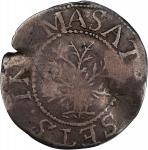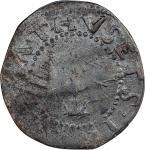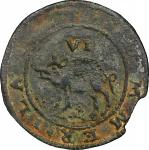Undated (ca. 1616) Sommer Islands Sixpence. BMA Type I, W-11445. Rarity-6. Large Portholes. EF-45 (PCGS).A stunningly well detailed specimen of this rare and challenging type. The hogge is not only complete, but well struck and nicely detailed, with finely rendered hair and a tuft of grass between his legs. The denomination is sharp, and the peripheral lettering is bold from 3 to 9 oclock. Portions of the rest of the legend are discernible with patience, though some areas are lost to corrosion related to this pieces ground exposure. On the reverse, the ship is fairly sharp, with good internal detail and four complete portholes, a good measure of the remaining part of the hull, masts and rigging more or less bold. The surfaces are attractive deep olive-brown with highlights of russet, smooth and glossy in some areas, and quite rough in others. The overall impression is that of a high grade specimen with a pleasing patina and bold visual appeal.<p>The European discovery of the Sommer Islands, or Bermuda Islands as they are known today, allegedly occurred in 1505, when they were visited by a Spaniard named Juan de Bermudez. British involvement did not come about until 1591, and then by accident, when Henry May, Captain Lancaster and others in their party were shipwrecked on the islands. Another, more significant shipwreck came in 1609 when nine ships carrying approximately 500 people bound for Virginia was driven ashore on the Bermuda Islands by a fierce hurricane. The castaways, who included Sir George Somers, found a ready supply of food in the form of the islands hog population. The first of these animals either found their way to the islands when Bermudez released some during his 1505 visit to serve as a food supply for shipwrecked mariners or were accidentally introduced by escaping from one of Bermudez ships when the Spaniard himself was stranded there during a later visit in 1532. Details of this incident are scarce and often conflicting, as they are with so many aspects of Sommer Islands coinage history. Regardless, the hogs were so important to the shipwrecked English colonists in 1609 that they became closely associated with the islands, hence the depiction of a hog on the obverse of the later coinage issue.<p>Although most of the English party managed to leave the islands in 1610 and make their way to Virginia, as originally intended, Somers returned later that year. He died shortly after arriving, on St. Georges Island, and the islands became known as the Sommer Islands in his honor. A larger party arrived from Virginia in 1612, this one spearheading a venture by a group of approximately 120 persons affiliated with the Virginia Company who had obtained a patent from King James I giving them authority over the area. From July 11 of that year until 1615 the islands were governed by Richard Moore and a series of short-lived successors under the umbrella of the Virginia Company. On June 29, 1615 the Bermuda Company was chartered as a separate entity, thereby ending the islands relationship with Virginia and the company which governed that colony.<p>Under the direction of a new governor Daniel Tuckar (or Tucker) who arrived in the middle of May 1616, initiatives were taken to help the islands meet expectations that they would eventually develop into a thriving settlement and port of call. A coinage had already been authorized by royal patent on June 29, 1615, upon the founding of the Bermuda Company. In his article entitled "The Somers Isles Hogge Money: A Theory About Their Mysterious Origin" published in the August 2009 issue of <em>The Colonial Newsletter</em>, Max Spiegel credits Charles Anthony with the design and die engraving of the so-called hogge money. Anthony was connected to the Royal Mint in the Bermuda Company. The author also notes, "the first emission of hogge money (assuming there was more than one striking) would have been produced [privately by hammer strike] sometime before the end of 1616." Spiegel continues:<p><em>The hogge money tokens most likely arrived sometime between May and December of 1616, and had fallen out of use within only a year and a half. [Mark] Sportack wrote that the coins were kept in circulation only by the colonists fear of Governor Tuckers regime, but [Louis] Jordan provides evidence that the hogge money had lost its usefulness while Tucker was still in power. Although Tucker was certainly not liked by the colonists, the end of his rule was not the reason that hogge money stopped being used. Rather, it was the changing economy of the Somers Isles that brought about the early demise of the hogge money.</em><p><em></em>Examples were struck in denominations of twopence, threepence, sixpence and shilling but, given that other commodities such as tobacco also served as useful mediums of exchange on the islands, the coins usefulness was short lived, as Louis Jordan observes, and by early 1618 they had been largely phased out. Mark Sportack further proposes that these coins were so detested late in their circulating life that many were thrown away as useless trash, and the mass deposit found at Castle Island in the 1990s supports this thesis.<p>Widely regarded as the first coins struck for the English colonies in the New World, the Sommer Islands pieces have been taken into the wider family of American colonial coinage by advanced numismatists. Prior to the late 20th century all denominations were considered extremely rare. Thanks to the advent of modern metal detecting equipment, however, many ground finds have been recorded since the early 1990s. On the other hand the total number of pieces discovered to date remains limited, the extant population in no way large enough to meet current (to say nothing of future) numismatic demand. The threepence, in particular, remains very rare and, given the manner in which most examples were discovered, Sommer Islands coinage as a group is extremely difficult to locate with overall smooth, problem-free surfaces. Most examples are extensively corroded, many to the point where they are barely identifiable as to type.<p>Of the 19 discrete examples of the Large Portholes variety of sixpence listed in the Bermuda Monetary Authoritys <em>Coins of Bermuda</em>, no fewer than 11 are impounded in institutional collections, including 10 in Bermuda and a specimen at the ANS. Others were not listed, including the superb Dittmer specimen (Heritage, May 2022, NGC AU-50 at $120,000) or the identically graded Newman coin (Heritage, May 2014, $129,250 and again in January 2020). The Roper-Royse example reappeared at Heritage in August 2019, and the following month a new specimen in relatively low grade (PCGS VF Details--Environmental Damage) sold at Heritage as well. The most recent to appear at auction is the PCGS Fine-12 from the Sydney F. Martin Collection, which realized $36,000 in our Spring (March) 2023 Auction. Four other individual examples of the Large Portholes variety, most rather corroded, were sold at auction between 2015 and 2018. There are at least two dozen of these now known and quite possibly a few more, although few approach the technical quality or eye appeal of the superb Eliasberg specimen offered here.PCGS# 5. NGC ID: AUBF.From the Louis E. Eliasberg, Sr. Collection.




















